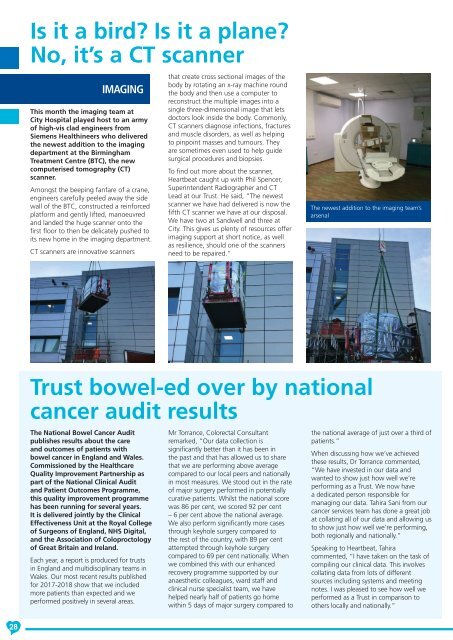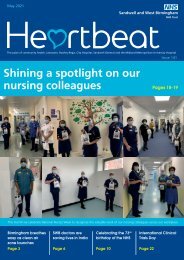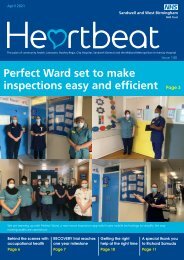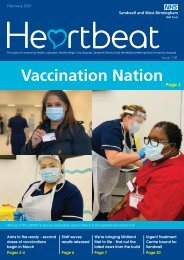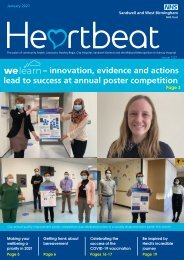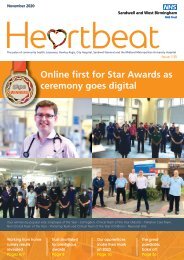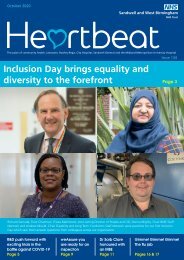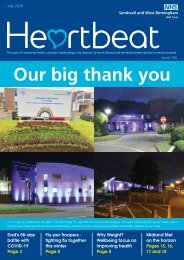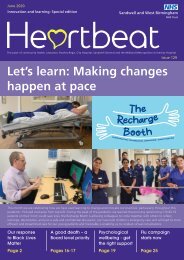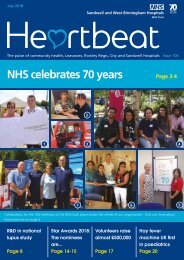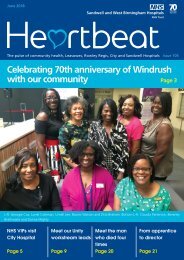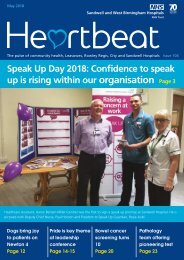Heartbeat March 2020
Create successful ePaper yourself
Turn your PDF publications into a flip-book with our unique Google optimized e-Paper software.
Is it a bird? Is it a plane?<br />
No, it’s a CT scanner<br />
IMAGING<br />
This month the imaging team at<br />
City Hospital played host to an army<br />
of high-vis clad engineers from<br />
Siemens Healthineers who delivered<br />
the newest addition to the imaging<br />
department at the Birmingham<br />
Treatment Centre (BTC), the new<br />
computerised tomography (CT)<br />
scanner.<br />
Amongst the beeping fanfare of a crane,<br />
engineers carefully peeled away the side<br />
wall of the BTC, constructed a reinforced<br />
platform and gently lifted, manoeuvred<br />
and landed the huge scanner onto the<br />
first floor to then be delicately pushed to<br />
its new home in the imaging department.<br />
CT scanners are innovative scanners<br />
that create cross sectional images of the<br />
body by rotating an x-ray machine round<br />
the body and then use a computer to<br />
reconstruct the multiple images into a<br />
single three-dimensional image that lets<br />
doctors look inside the body. Commonly,<br />
CT scanners diagnose infections, fractures<br />
and muscle disorders, as well as helping<br />
to pinpoint masses and tumours. They<br />
are sometimes even used to help guide<br />
surgical procedures and biopsies.<br />
To find out more about the scanner,<br />
<strong>Heartbeat</strong> caught up with Phil Spencer,<br />
Superintendent Radiographer and CT<br />
Lead at our Trust. He said, “The newest<br />
scanner we have had delivered is now the<br />
fifth CT scanner we have at our disposal.<br />
We have two at Sandwell and three at<br />
City. This gives us plenty of resources offer<br />
imaging support at short notice, as well<br />
as resilience, should one of the scanners<br />
need to be repaired.”<br />
The newest addition to the imaging team’s<br />
arsenal<br />
Trust bowel-ed over by national<br />
cancer audit results<br />
The National Bowel Cancer Audit<br />
publishes results about the care<br />
and outcomes of patients with<br />
bowel cancer in England and Wales.<br />
Commissioned by the Healthcare<br />
Quality Improvement Partnership as<br />
part of the National Clinical Audit<br />
and Patient Outcomes Programme,<br />
this quality improvement programme<br />
has been running for several years.<br />
It is delivered jointly by the Clinical<br />
Effectiveness Unit at the Royal College<br />
of Surgeons of England, NHS Digital,<br />
and the Association of Coloproctology<br />
of Great Britain and Ireland.<br />
Each year, a report is produced for trusts<br />
in England and multidisciplinary teams in<br />
Wales. Our most recent results published<br />
for 2017-2018 show that we included<br />
more patients than expected and we<br />
performed positively in several areas.<br />
Mr Torrance, Colorectal Consultant<br />
remarked, “Our data collection is<br />
significantly better than it has been in<br />
the past and that has allowed us to share<br />
that we are performing above average<br />
compared to our local peers and nationally<br />
in most measures. We stood out in the rate<br />
of major surgery performed in potentially<br />
curative patients. Whilst the national score<br />
was 86 per cent, we scored 92 per cent<br />
– 6 per cent above the national average.<br />
We also perform significantly more cases<br />
through keyhole surgery compared to<br />
the rest of the country, with 89 per cent<br />
attempted through keyhole surgery<br />
compared to 69 per cent nationally. When<br />
we combined this with our enhanced<br />
recovery programme supported by our<br />
anaesthetic colleagues, ward staff and<br />
clinical nurse specialist team, we have<br />
helped nearly half of patients go home<br />
within 5 days of major surgery compared to<br />
the national average of just over a third of<br />
patients.”<br />
When discussing how we’ve achieved<br />
these results, Dr Torrance commented,<br />
“We have invested in our data and<br />
wanted to show just how well we’re<br />
performing as a Trust. We now have<br />
a dedicated person responsible for<br />
managing our data. Tahira Sani from our<br />
cancer services team has done a great job<br />
at collating all of our data and allowing us<br />
to show just how well we’re performing,<br />
both regionally and nationally.”<br />
Speaking to <strong>Heartbeat</strong>, Tahira<br />
commented, “I have taken on the task of<br />
compiling our clinical data. This involves<br />
collating data from lots of different<br />
sources including systems and meeting<br />
notes. I was pleased to see how well we<br />
performed as a Trust in comparison to<br />
others locally and nationally.”<br />
28


